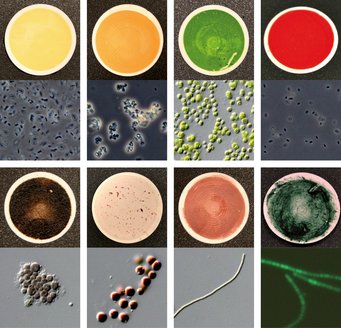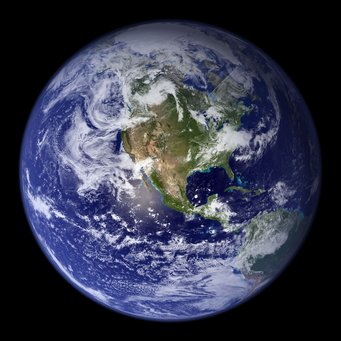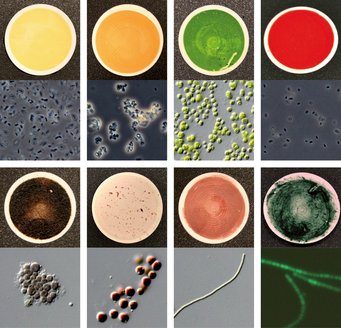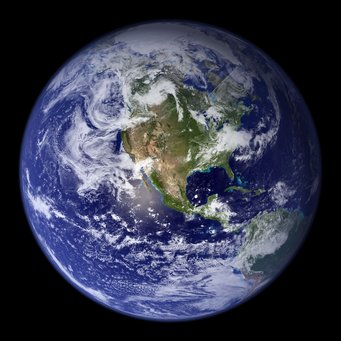The diversity of alien colors: How to recognize life on distant planets
Astronomers and biologists led by MPIA graduate student Siddharth Hegde have measured the "chemical fingerprints" of 137 different species of microorganisms. This could help future astronomers to recognize life on the surface of exoplanets (planets outside our solar system). Some of the microorganisms hail from the most extreme environments on Earth; taken together, the samples should allow for a (cautious) estimate of the diversity of biological colors on planets other than Earth. The results are available in an online catalogue and have also been published in the Proceedings of the National Academy of Sciences of the United States of America (PNAS).
| Background information | Questions and Answers | Images |

Von oben links nach unten rechts: Unbekannte Art vom Genus Bacillus (Sonoran-Wüste, Arizona, USA); unbekannte Art vom Genus Arthrobacter (Atacamawüste, Chile); Chlorella Protothecoides (Harz einer beschädigten Silberpappel); unbekannte Art vom Genus Ectothiorhodospira (Big Soda Lake, Nevada, USA); unbekannte Art vom Genus Anabaena (mit grün fluoreszierendem Protein; stehendes Süßwasser-Gewässer); unbekannte Art vom Genus Phormidium (Kamori Channel, Palau); Porphyridium purpureum (altes Holz an salziger Quelle, Boone's Lick State Park, Missouri, USA); Dermocarpa violacea (Aquariumwasser, La Jolla, Kalifornien, USA).
Astronomers are gearing up for a new phase of research on exoplanets (planets outside our solar system), teaming up with biologists to formulate search strategies for life on these distant planets. So far, these efforts have focused on what are known as indirect biosignatures, such as byproducts of life that could be detectable in a host planet's atmosphere.
But if the surface of an exoplanet were dominated by one particular life form, a more direct form of detection might be possible: a detection based on light reflected by that life form, taking on a characteristic tint in the process.
We observe planets by studying starlight reflected off their atmospheres or surfaces. When Jupiter or Venus shines brightly in the night sky, the light you see is sunlight reflected by those planets. Alien astronomers making detailed observations of Earth would notice a greenish tint as sunlight reflected by trees and other vegetation reaches their telescopes.
Similarly, the presence of an alien organism covering large swathes of an exoplanet surface could be measured directly through the imprint left by the organism's pigmentation, the chemical makeup that determines its color. This imprint is the reflected light's spectrum: the light split up, rainbow-light, into component colors. It is the chemical analogue of a fingerprint, allowing for the identification of different types of microorganisms.
Now, a group of astronomers and biologists led by Siddharth Hegde has teamed up to explore what these fingerprints might look like and how diverse they could be. Hegde, then a graduate student at the Max Planck Institute for Astronomy, and astronomer Lisa Kaltenegger (Director of the Institute for Pale Blue Dots at Cornell University) teamed up with biologist Lynn Rothschild, postdoctoral fellow Ivan Paulino-Lima and research associate Ryan Kent, all of the NASA Ames Research Center, to explore the full range of possibilities for what chemical fingerprints – and therefore exoplanet surface biosignatures – could look like.
To this end, the team assembled cultures of 137 different species of microorganisms: 36 from existing culture collections, 100 assembled by Paulino-Lima, and one isolated by Rocco Mancinelli of the BAER Institute at Ames. A primary concern in selecting species was diversity of pigmentation: The 137 life forms span a variety of colors and are residents of a variety of environments, ranging from the Atacama desert in Chile, to seawater in Hawaii, to some old woodwork at Salt Spring in Boone’s Lick State Park, Missouri.
The team reflected light off samples from each microorganism culture, measured their chemical fingerprints, and assembled their findings in an online catalog. This biosignature catalog (which consists of reflectance spectra in the optical and near-infrared wavelength regions of the electromagnetic spectrum, 0.35-2.5 micrometers) is the most complete and diverse to date, and the first dedicated to surface biosignatures for exoplanets.
The team has plans to collect more samples and to add more fingerprints to the catalog, in order to further enhance the diversity of the microorganisms represented. They hope that it will be helpful not only to astrobiologists, but also to astronomers who are trying to make models of planetary atmospheres. However, even with the next generation of telescopes, detecting the fingerprints of organisms living on planetary surfaces will be highly technically challenging. At the moment, it is not possible to directly measure light from an Earth-sized planet, because this light is drowned out by the much-brighter neighboring starlight. For now, Kaltenegger says, "this (database) gives us for the first time a glimpse into the detectable signatures of the fascinating diversity of worlds that could exist out there.”
Background information
The results described here have been published in the Proceedings of the National Academy of Sciences of the United States of America (PNAS) as Hegde et al.: "Surface biosignatures of exo-Earths: Remote detection of extraterrestrial life."
The authors are Siddharth Hegde (MPIA), Ivan G. Paulino-Lima (NASA Postdoctoral Program Fellow, NASA Ames Research Center), Ryan Kent (UCSC UARC at NASA Ames), Lisa Kaltenegger (MPIA and Institute for Pale Blue Dots, Cornell University), and Lynn Rothschild (NASA Ames).
PNAS provides journalists with access to embargoed content - including the Hegde et al. article - through EurekAlert! Journalists can register with EurekAlert at http://www.eurekalert.org/register.php and request access to PNAS materials. If they are already registered with EurekAlert, they can request access to PNAS at http://www.eurekalert.org/account.php
This work was carried out as part of a NASA Planetary Biology Internship Award (PBI) that Hegde received in 2013. Starting in May 2015, Hegde will be a post-doctoral Research Associate at the Institute for Pale Blue Dots at Cornell University, where the biosignature database is hosted:
The biosignature catalog is online at http://biosignatures.astro.cornell.edu
Questions and answers
What is new and/or important about the result?
The 137 biosignatures make up the most complete and diverse biosignature catalog to date. These fingerprints of life have been measured before, but primarily for plants. Microorganisms have much greater diversity of pigmentation than land plants, enabling the team to anticipate a broader range of possibilities for what reflective biosignatures of exoplanet surfaces could look like.
For now, the catalog primarily serves to illustrate the potential diversity of extrasolar life. It also illustrates the potential diversity of extrasolar planets, because particular pigments arise out of particular environmental conditions and can thus provide clues regarding the nature of the planet. In addition, because the surface of a planet affects its atmosphere, these biosignatures could be used as initial conditions for models of exoplanet atmospheres (called “atmospheric radiative transfer models”). More precisely, the surface composition determines how much radiation is reflected back from the surface and used in chemical processes in the atmosphere.
What makes microorganism biosignatures a plausible preview of extraterrestrial life?
Single-celled microorganisms dominate the history of life on Earth: they have been residents of Earth’s surface for at least 3.5 billion years (the Earth itself is 4.5 billion years old) whereas plants have only been around for the past 460 million years. Furthermore, they represent the extremes of the diversity of life: Microorganisms called extremophiles, literally "lovers of extreme environments", have time and time again surprised biologists with their hardiness: they can be found in some of the most extreme physical and geochemical environments on Earth, from hot springs in Yellowstone National Park, to Antarctica, to the interior of the Chernobyl nuclear reactor.
Since biologists believe that there are limits to the forms life can take (for example, all life on Earth requires liquid water) collecting biosignatures from extremophiles enabled the team to account for a wide range of possibilities for physical and geochemical conditions on exoplanets, and accordingly a wide range of possibilities for what the dominant form of life on a particular planet could be.
What’s the difference between a biosignature and signatures of non-living material?
When the team assembled their catalog, they observed that the fingerprint of a microorganism is primarily determined by its pigmentation makeup. This makeup is a result of secondary metabolic processes, which are unique to life forms and play important roles in photosynthesis, in screening harmful ultraviolet radiation, and in preventing oxidative damage. Thus, recognizing a particular pigmentation makeup through a biosignature corresponds to recognizing a type of living being.
Where did the samples come from?
36 samples came from existing culture collections: 21 from the Culture Collection of Algae at the University of Texas, Austin; eight from the Kudela Lab at the University of California, Santa Cruz; six from the Rothschild Lab at the NASA Ames Research Center in California; and one from the Saltikov Lab at the University of California, Santa Cruz. The rest were isolated from a variety of source locations, 100 by Ivan Paulino-Lima and one by Rocco Mancinelli.
Where and how were the biosignatures measured?
Hegde, Paulino-Lima and Kent measured the sample biosignatures at the Center for Spatial Technologies and Remote Sensing (CSTARS) at the University of California, Davis. They used a setup called an integrating sphere, which is hollow and lined on the inside with a reflective coating. The integrating sphere contained a hole for the light source, the microorganism sample, and a detector to measure the fingerprint in the reflected light from the sample. The effect of the sphere shape is as follows: when light shines through the hole and reflects off the sample, it is distributed evenly in all directions. Therefore, the detector can be placed anywhere in the sphere, against any part of the wall, and still measure the same averaged ("integrated") fingerprint. This is important because for the foreseeable future, telescopes will only be able to measure reflected light from an exoplanet that has been averaged over the whole of the visible part of the planet's surface.
Can we already measure reflectance biosignatures from extrasolar planets?
To directly measure light reflecting off the surface of a planet, a telescope would have to be able to distinguish it from the neighboring starlight. However, a star is many orders of magnitude brighter than a planet, and this process will be extremely technically challenging even for the next generation of telescopes.
In the meantime, what will these biosignatures be used for?
For now, the catalog primarily serves to illustrate the potential diversity of extrasolar life. It also illustrates the potential diversity of extrasolar planets, because particular pigments arise out of particular environmental conditions and can thus provide clues regarding the nature of the planet. In addition, because the surface of a planet affects its atmosphere, these biosignatures could be used as initial conditions for models of exoplanet atmospheres (called “atmospheric radiative transfer models”). More precisely, the surface composition determines how much radiation is reflected back from the surface and used in chemical processes in the atmosphere.
Images

Download area





